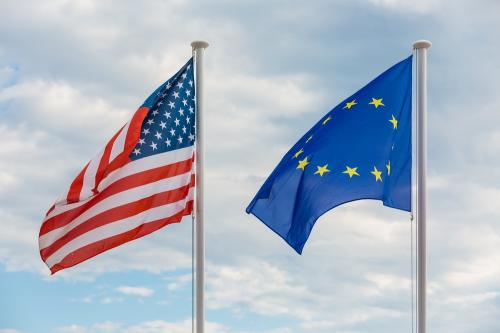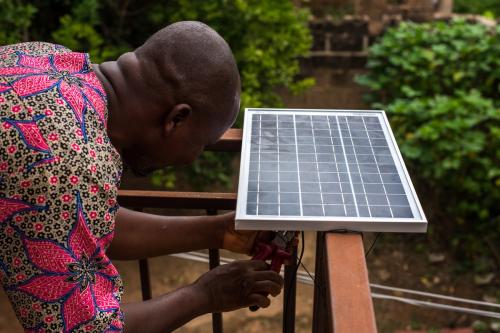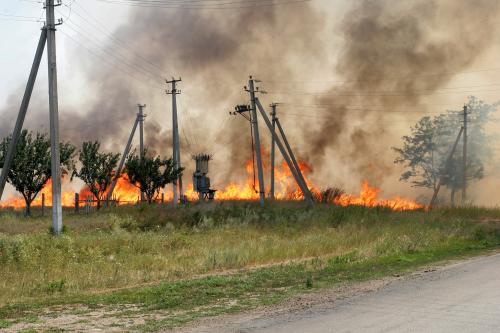A Carbon Border Adjustment Mechanism (CBAM) (also known as a Carbon Border Adjustment Tax, or CBAT) is a fee or tariff levied on imported goods based on the greenhouse gases emitted during their production. Such a policy can serve multiple purposes, such as reducing emissions to restrain climate change, preventing distortions between countries with differing emissions standards, and spurring domestic industries. This post explains how CBAMs work and the debate over CBAMs and their implementation.
Why implement a CBAM?
The goal of a CBAM is to help reduce emissions that contribute to global warming and to encourage cleaner production processes around the world. Goods made in countries with less stringent emissions standards are cheaper to produce but result in higher greenhouse gas emissions. This gives firms an incentive to move production (and pollution) to countries with lower standards and gives producers in those countries a cost advantage over producers in countries with more aggressive climate change standards. The objective of a CBAM is to eliminate that advantage, known as carbon leakage, imposing the same price on the carbon content of a traded good whether it is made abroad or at home.
A CBAM could help the European Union and other countries achieve their global climate policy ambitions, make domestic industries more competitive, and bolster trade relationships with like-minded allies and partners. And the United States could use a CBAM to help with its geopolitical competition with China, the largest global emitter of carbon dioxide. The policy may also serve as a source of government revenue and encourage other countries to adopt carbon prices.
What is a carbon price?
A carbon price tries to capture the adverse externality of greenhouse gas emissions (the indirect cost of emitting greenhouse gases borne by the public) by pricing carbon within an economy or region. A carbon price can be a carbon tax—directly taxing emitters—or an emissions trading system (ETS, or cap-and-trade system), which fixes the supply of greenhouse gas emissions in an economy and allows firms to trade emission credits amongst themselves. CBAMs are traditionally designed to be paired with carbon prices.
How does a CBAM work?
The first step for a government implementing a CBAM is to determine the cost of the carbon embedded in the manufacture of a given imported good, a calculation that requires determining the quantity of carbon emitted in the production of the good and putting a price on that carbon. That cost is compared to the cost of carbon that domestic producers pay to make the same good. If the foreign producer paid a lower cost per unit of emissions than the domestic producer, the CBAM tariff is the difference. (In the absence of a carbon tax or domestic cap-and-trade system, neither of which have been adopted in the U.S., this calculation is difficult.)
In practice, the comparison is complicated. Policymakers must establish which industries will be covered, decide how to measure domestic and foreign emissions, and specify which emissions—direct (those resulting from the production of the good) and indirect (those resulting from the inputs to production of the good)—will be counted. The government must then determine who it will tax and how much, and set prices for emissions from abroad.
Policymakers must also determine how to levy CBAM taxes on products. One option is an import fee, making foreign, carbon-intensive products more expensive in domestic markets. Another route is an export rebate, which gives domestic producers a rebate when exporting their goods. Import fees and export rebates can be employed together: the former punishes high-pollution producers, while export rebates reward green production and innovation. Export rebates may violate World Trade Organization (WTO) rules against subsidies.
Who has adopted a CBAM?
The European Union adopted a CBAM in October 2023 to put “a fair price on the carbon emitted during the production of carbon-intensive goods that are entering the EU and to encourage cleaner industrial production in non-EU countries.” The CBAM is part of a suite of climate policies complementing an ETS as the EU aims to achieve net-zero emissions by 2050. The UK plans to implement a similar policy in 2027. Australia, Canada, and Turkey are exploring the option.
The EU intends to implement its CBAM in two phases. In the first phase, importers in carbon-intensive industries most prone to leakage—of aluminum, cement, electricity, fertilizers, hydrogen, iron, and steel—must report quarterly the greenhouse gases they emit by producing their goods domestically and abroad. In the second phase, slated to begin in 2026, importers of carbon-intensive goods will start paying taxes based on the carbon price in Europe’s ETS, and the number of industries mandated to report emissions will expand. The EU will conduct a review of its CBAM in 2027. The CBAM has been estimated to bring in €7.2 billion annually for the EU.
Is the U.S. considering a CBAM?
Members of both parties in Congress have floated different versions of a CBAM.
The Clean Competition Act, introduced by Sen. Sheldon Whitehouse (D-RI) and Rep. Suzan DelBane (D-WA-01), aims to, in the words of Whitehouse, “give domestic companies a step up in the global marketplace while lowering carbon emissions at home and abroad, and ultimately steering the planet toward climate safety.” The bill would charge fees to domestic and foreign manufacturers polluting above industry-specific benchmarks calculated by the Treasury Department. Like the CBAM in Europe, the proposal would be implemented in two stages: high-emissions industries would be targeted in 2025, with specified others to follow in 2027. The revenue from fees would fund decarbonization at home and abroad.
Another proposal, the Foreign Pollution Fee Act, proposed in November 2023 by Sen. Bill Cassidy (R-LA) and co-sponsored by Sen. Lindsay Graham (R-SC), aspires to “[leverage] the cleaner emissions profile of U.S. producers relative to their foreign competitors, [to rein] in China and Russia and [weaken] their control of global supply chains.” As with the Clean Competition Act, the Treasury would determine industry-wide emissions benchmarks for domestic manufacturers, but the bill avoids imposing any fees or costs on U.S. firms. The proposal exempts coverage of products critical for national security and originating from countries with a formal free trade agreement with the U.S.
What are the challenges to CBAMs achieving the goal of reducing global emissions?
Measuring carbon emissions of products is difficult, especially in complex global supply chains, and the resulting data may be neither reliable nor robust. Political pressures may limit the scope of the CBAM. By targeting industrial manufacturing and ignoring high-polluting industries such as transport and agriculture, the EU’s CBAM may be insufficient to reach the EU’s climate goals. European manufacturers are also concerned about complex rules and increased production costs as the implementation of the CBAM is likely to require them to purchase carbon-emission permits that they currently get for free. And implementation could be delayed—as of March 2024, only 10% of firms in Germany and 11% in Sweden have reported their emissions as required in the EU.
What do least developed countries say about CBAMs?
Many low- and middle-income countries are critical of Europe’s CBAM, viewing it as an unfair and hypocritical tax on their exports. They contend that Western countries became wealthy by burning fossil fuels, are responsible for the bulk of historical global emissions, and have spent decades financing and promoting fossil fuel development and outsourcing pollution to emerging markets. On the other hand, they argue that least developed countries (LDCs) want to grow, emit small amounts of greenhouse gases compared to their richer counterparts, lack the institutional capacity to monitor emissions or invest in green technology, and expect to bear the brunt of climate change. The EU says it wants to help LDCs with the green transition and provide technical support for complying with the CBAM.
CBAMs could run afoul of WTO rules, cause trade wars, or be hard to coordinate with allies. China, India, and South Africa dispute the legality of the EU’s CBAM and plan to challenge the policy at the WTO. China, among the countries most exposed to Europe’s CBAM, has been particularly critical: its leaders have argued that the CBAM could undermine the global fight against climate change and slow the green energy transition. The EU disagrees, arguing that they designed their CBAM according to WTO rules.
-
Acknowledgements and disclosures
The Brookings Institution is financed through the support of a diverse array of foundations, corporations, governments, individuals, as well as an endowment. A list of donors can be found in our annual reports published online here. The findings, interpretations, and conclusions in this report are solely those of its author(s) and are not influenced by any donation.









Commentary
What is a Carbon Border Adjustment Mechanism?
July 8, 2024